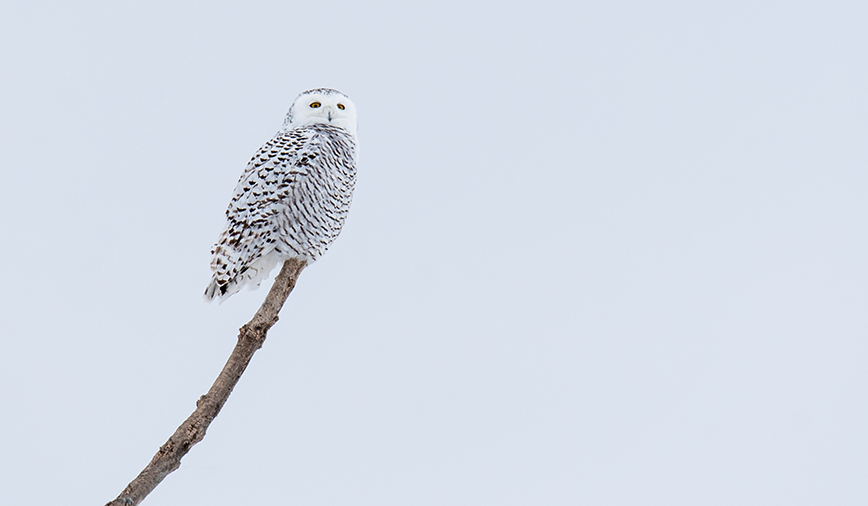December 27, 2013
Snowy Owl
Not only do I remember where I saw my first white owl, I also remember when. I was four years old, poking around my grandmother’s basement, when I spotted it: A serious-looking bird, staring out at me from the label on the inside lid of a cigar box.
I was more than a little surprised to see it there, since all the other boxes on the workbench were Dutch Masters and Muriel—brands I felt I knew. (Let’s just say, even at that tender age, I’d had more than a few puffs on my uncles’ cigars. But that’s another story for another time.) Suffice it to say, that White Owl really threw me for a loop.
Little did I know that, a scant 47 years later, I’d again be loopy over a white owl. But this one’s not on a box. It’s Bubo scandiacus, the snowy owl.
Besides cigar boxes, snowy owls were popularized by the Harry Potter franchise. A bird whose summer, or breeding, territory stretches north of the Arctic Circle, snowies are occasional winter visitors to the United States. Up north, their populations fluctuate with the availability of prey, which consists mainly of lemmings and ptarmigans but also includes other small mammals, ducks, geese and the occasional seabird.
When prey is plentiful, snowy owl numbers go up. When prey animals diminish, either through pressure from predators or due to severe weather, snowies need to disperse. A movement, or migration, of great numbers of birds is called an irruption.
These ups and downs, in the past, have followed a general pattern repeating about every four years. The last major snowy owl irruption in our area in was in the winter of 2011-12 so, technically, we wouldn’t be “due” for a visit for another couple of years.
However, as every naturalist knows, animals—even wise old owls—never pay attention to scientific literature. But for those of us who do, reports from the field are indicating that the
eastern half of the United States is in the midst of a massive—possibly record-breaking—irruption.
I first found out something was up with B. scandiacus in early December, when a Wisconsin Department of Natural Resources press release reported a large number of snowies in the northern half of the state. It was only a matter of time before the birds dispersed farther south, and showed up here in Illinois.
On December 14, when a group of Kane County Audubon members stopped by Hickory Knolls during their Christmas Bird Count rounds, the conversation quickly turned to snowies. Besides talk of recent sightings—including a snowy at the Jewel on the east side of St. Charles—Chris Madsen and I reminisced about how White Sox announcer Bob Elson would call a home run a White Owl wallop.
How cool would it be to feel the wallop of seeing a bona fide, snowy-white owl in Kane County?
Now, two weeks later, dozens of snowy owl sightings have been reported in Illinois, with the majority showing up in areas that offer habitat similar to the birds’ northern homeland—coastal areas as well as flat or rolling tundra-like expanses.
The Lake Michigan shoreline, particularly near Montrose Harbor, is a popular place to spot a snowy. And with the spate of cold weather we endured, and are expecting more of, the list of “tundra-like expanses” is lengthy and expected to grow. Cornfields. Airport landing fields. Actually open fields of just about any type, provided prey animals are present.
Other than the Jewel sighting in early December, and another one at the Walmart in Huntley, reports of snowies in Kane County have been concentrated in the southern sectors, near Sugar Grove and the Aurora Airport.
If you’d like to see a snowy of your own, go for it! But please be respectful of these birds, many of which are stressed and hungry. If luck is with you and you spot one, don’t make any sudden moves or loud noises. Take a picture if you’d like, but use your biggest telephoto lens or
maximum zoom so you can keep your distance. Any time these birds have to take flight, they will be burning hard-earned calories that most can’t afford to lose.
One other thing you can do, as a help to fellow birders and researchers alike, is report your sighting on the Internet. www.ebird.org, maintained by the Cornell Lab of Ornithology and the National Audubon Society, welcomes reports from across the country. On a local level, you can let birders know of your good fortune by sending an email to Kane County Audubon at sightings@kanecountyaudubon.org. Your report will be displayed on the group’s web site, www.kanecountyaudubon.org.
Here’s hoping at least some of us will feel the thrill of a white owl wallop this winter. Good luck, and good birding!
Pam Otto, who also wouldn’t mind hearing about your snowy owl sightings—even if they are on cigar boxes, which she collects—is the manager of nature programs and interpretive services for the St. Charles Park District. She can be reached at 630-513-4346 or potto@stcparks.org.

